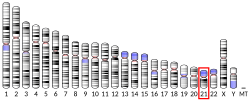A proteolysis targeting chimera (PROTAC) is a molecule that can remove specific unwanted proteins. Rather than acting as a conventional enzyme inhibitor...
16 KB (1,635 words) - 03:05, 24 March 2025
Bavdegalutamide is an experimental proteolysis targeting chimera that functions as a androgen receptor degrader. It is being developed to treat metastatic...
6 KB (131 words) - 10:41, 28 May 2025
is an experimental estrogen receptor degrader that works via proteolysis targeting chimera. It is developed for advanced estrogen receptor positive breast...
4 KB (173 words) - 18:29, 21 October 2024
molecule therapeutics and the pool of potential protein targets. Proteolysis-targeting chimeras (PROTACs) were first reported by Kathleen Sakamoto, Craig...
18 KB (2,120 words) - 03:08, 28 May 2025
experimental anticancer drug which is one of the first examples of a proteolysis targeting chimera or PROTAC. It is a bifunctional molecule with two halves joined...
5 KB (314 words) - 09:50, 6 March 2025
prostate cancer (mCRPC). It belongs to a class of drugs called proteolysis targeting chimeras (PROTACs), which are designed to selectively degrade specific...
6 KB (233 words) - 20:22, 16 May 2025
prostate cancer (mCRPC). It belongs to a class of drugs called proteolysis targeting chimeras (PROTACs), which are designed to selectively degrade specific...
7 KB (270 words) - 01:09, 22 May 2025
cases, proteins can potentially be targeted for degradation using the novel drug modality of proteolysis-targeting-chimeras (PROTACs). PROTACs are heterobifunctional...
63 KB (6,159 words) - 14:33, 30 November 2024
Cereblon (section Targeted protein degradation)
ligands for other proteins of interest. These molecules, termed proteolysis targeting chimeras (PROTACs) or protein degraders, recruit CRBN to a protein of...
12 KB (1,350 words) - 15:54, 25 May 2025
morphological profiling enables high-throughput screening for PROteolysis TArgeting Chimera (PROTAC) phenotypic signature". doi:10.1101/2022.01.17.476610...
11 KB (1,095 words) - 05:58, 27 May 2025
the discovery of PROteolysis-TArgeting Chimeras (PROTACs) to trigger degradation of disease-causing proteins, a process known as targeted protein degradation...
38 KB (3,560 words) - 00:04, 27 May 2025
targeted protein degradation and modulating protein-protein interactions. One example of this type of work is the discovery of proteolysis-targeting chimera...
12 KB (1,112 words) - 15:54, 22 May 2025
Leukemia (AML). Its targeting, either by the small-molecule inhibitor IPI-549 or by a first-in-class proteolysis-targeting chimera (PROTAC) named ARM165...
5 KB (640 words) - 09:27, 19 March 2025
Ubiquitin ligase (section Targeted protein degradation)
the development of proteolysis-targeting chimeras (PROTACs). Using a small molecule to recruit an E3 ubiquitin ligase to a target protein, this work demonstrated...
40 KB (4,436 words) - 21:52, 23 May 2025
Cruciani G, Desantis J, Goracci L (September 2023). "VHL-Modified PROteolysis TArgeting Chimeras (PROTACs) as a Strategy to Evade Metabolic Degradation in In...
11 KB (1,293 words) - 22:38, 21 December 2023
of proteolysis targeting chimeras (PROTACS), which are bifunctional molecules that harness the cells ubiquitin-proteasome system to degrade targets of...
13 KB (1,230 words) - 09:25, 19 February 2025
Based on a close analog of the ERK5 inhibitor BAY-885 the Proteolysis Targeting Chimera (PROTAC) INY-06-061 was developed which allows to compare the...
17 KB (1,995 words) - 02:41, 29 April 2025
B, Yang Z, Ren Y, et al. (May 2022). "Novel CRBN-Recruiting Proteolysis-Targeting Chimeras as Degraders of Stimulator of Interferon Genes with In Vivo...
4 KB (279 words) - 00:39, 17 May 2025
Zheng X, Liyan C, Zhang Z, Wang J, Shen Z (January 2021). "Proteolysis targeting chimera (PROTAC) in drug discovery paradigm: Recent progress and future...
15 KB (1,243 words) - 23:07, 8 May 2025
B, Yang Z, Ren Y, et al. (May 2022). "Novel CRBN-Recruiting Proteolysis-Targeting Chimeras as Degraders of Stimulator of Interferon Genes with In Vivo...
5 KB (446 words) - 00:45, 17 May 2025
et al. (April 2021). "DCAF11 Supports Targeted Protein Degradation by Electrophilic Proteolysis-Targeting Chimeras". Journal of the American Chemical Society...
4 KB (474 words) - 01:13, 20 May 2024
1038/s41589-022-01059-7. PMID 35676539. "Supplemental Information 4: UCSF Chimera". doi:10.7717/peerj.4593/supp-4. {{cite web}}: Missing or empty |url= (help)...
25 KB (2,644 words) - 17:17, 5 February 2025
β-glucuronidase is synthesized as an 80 kDa monomer (653 amino acids) before proteolysis removes 18 amino acids from the C-terminal end to form a 78 kDa monomer...
24 KB (2,644 words) - 18:43, 11 December 2023
cleaved and processed by other proteases. The mechanisms behind the proteolysis of TMEM106B is of interest because it is thought to be a factor in what...
27 KB (2,786 words) - 05:51, 11 June 2024
hydrolyze. The breakdown of proteins to small peptides and amino acids (proteolysis) is a step in digestion; these breakdown products are then absorbed in...
105 KB (10,957 words) - 13:53, 25 May 2025
templates for chimeras. This method begins with the preparation of single stranded DNA fragments by reverse transcription from target mRNA. Gene specific...
58 KB (7,426 words) - 16:18, 25 May 2025
Stichodactyla toxin (section Channel targets)
PEGylation can also decrease immunogenicity and protect a peptide from proteolysis and non-specific adsorption to inert surfaces. PEGylated ShK[Q16K] prevented...
75 KB (8,640 words) - 17:48, 26 May 2025
mice: 439 Synthetically produced toxins and genetically engineered toxin chimeras are areas of emerging interest because of their possible application as...
20 KB (2,553 words) - 01:37, 10 May 2025
















